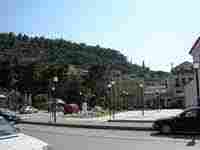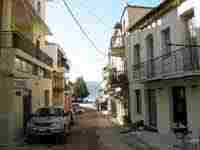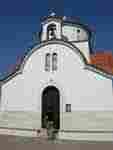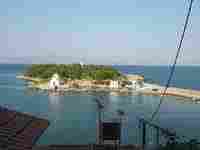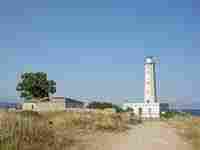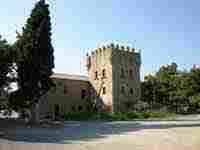.


Administrative Region : Peloponnese
Regional unit : Lakonia
Gytheio (Greek: Γύθειο, [ˈʝiθio]), the ancient Gythium or Gytheion (Ancient Greek: Γύθειον), is a town and a former municipality in Laconia, Peloponnese, Greece. Since the 2011 local government reform it is part of the municipality East Mani, of which it is a municipal unit.[1] It was the seaport of Sparta, some 40 km north. Gytheio used to be an important port until it was destroyed in 4th century AD, possibly by an earthquake. Today it is the largest and most important town in Mani. It is also the seat of the municipality of East Mani.
Nearest Places
South: Mavrovouni.
West: Rachi
North: Stefania
East: Cranae
Historical population
Year Town Municipality
1830[2] 500-700 -
1910[2] 2,000+ -
1981 4,354 -
1991 4,259 7,542
2001[3] 4,489 7,926
Geography
View of the promenade.
Gytheio is located in the north-east corner of Mani. It lies on the north-western end of the Laconian Gulf. Gytheio was built on a hill called Koumaros or Laryssio in one of the most fertile areas in Mani, near the mouth of the Gythium River, which is usually dry and has been given the nickname of "Xerias", meaning 'dry' (Today most of the "Xerias" dry river is covered by "Ermou Avenue"). Further north-east is the delta of the Evrotas River. Gytheio is built on hilly ground overlooking the Laconian Gulf. Offshore of Gytheio are several small islands, the most important of these being Cranae, which is connected to the mainland by a causeway. Gytheio is only 40 km southeast of Sparta.
History
The reputed founders of ancient Gythium were Heracles and Apollo,[4] who frequently appear on its coins or in other legends, and Castor and Pollux[5]: the former of these names may point to the influence of Phoenician traders from Tyre, who, we know, visited the Laconian shores at a very early period.[6] It is thought that Gytheio may have been the center of their purple dye trade because the Laconian Gulf had a plentiful source of murex. In classical times it was a community of Perioeci, politically dependent on Sparta, though doubtless with a municipal life of its own.

1453 : Agathokleia. Votive relief. Marble.
In 455 BC, during the First Peloponnesian War, it was burned by the Athenian admiral Tolmides who besieged the city with 50 ships and 4,000 hoplites.[5][7] It was rebuilt and was most probably, the building ground for the Spartan fleet in the Peloponnesian War. In 407 BC during the Peloponnesian War, Alcibiades landed there and saw the thirty triremes the Spartans were building there.[5][8] In 370 BC, the Thebans under the command of Epaminondas besieged the city successfully for three days after ravaging Laconia.[5] However it was recaptured by the Spartans three days later.
Map showing Gythium in ancient Greece.
Ancient Theatre of Gythio.
In 219 BC, Philip V of Macedon tried to capture the city but without success.[5] Under Nabis, Gythium became a major naval arsenal and port. During the Roman-Spartan War, Gythium was captured after a lengthy siege. After the war finished, Gythium was made part of the Union of Free Laconians under Achean protection.[9] Nabis recaptured Gythium three years and the Spartan fleet defeated the Achean fleet outside of Gythium. Gythium was liberated by a Roman fleet under the command of Aulus Atilius Serranus.
Subsequently Gythium formed the most important of the Union of Free Laconians, a group of twenty-four, later eighteen, communities leagued together to maintain their autonomy against Sparta and declared free by Caesar Augustus.[10] The highest officer of the confederacy was the general, who was assisted by a treasurer (rauias), while the chief magistrates of the several communities bore the title of ephors.
In Roman times Gythium remained a major port and it prospered as a member of the Union.Roman Gythium[›][9] As purple dye was popular in Rome, Gythium exported that as well as porphyry and rose antique marble.[5]. Evidence of the ancient Gythium prosperity can be found by the fact that the Romans built an ancient theatre which is well preserved today and is still used occasionaly. The ancient theatre, as well as the city's Acropolis (west to the location of the theatre) discovered by the archeologist Dimitris Skias on 1891. Some time in the 4th century AD, Gythium was destroyed.[5] What happened to Gythium is not recorded but it is thought to have been either sacked by Alaric and Visigoths, pillaged by the Slavs or destroyed by the massive earthquake that struck the area in 375 AD.[5]
After the earthquake Gythium was abandoned. It remained a small village throughout the Byzantine and Ottoman times. Its importance grew when Tzannetos Grigorakis built his tower at Cranae and more people came and settled at Gytheio.[5] But during the Greek War of Independence, refugees flooded into Mani and made Gytheio a major town.[2]
|
|
|
|
|
|
|
|
|
|
|
Historical population
The modern Gytheio opened a port in the 1960s. Ferries sail from Gytheio to Kythira almost daily and also to Crete twice a week. It is the See of the Diocese of Gytheion and Oitylo, headed by a Metropolitan bishop of the Orthodox Church of Greece. Gytheio is the largest and most important town in Mani. Most of the ruins of ancient Gythium are now submerged in the Laconian Gulf. Some walls' remains can be seen today on the sandy beach of Valtaki and in the shallow waters, where the well known Dimitrios shipwreck lies stranded. It is also the capital of the municipality of Gytheio.
From 2003 to 2004, the show which was broadcast on Mega Channel Vendetta, a drama-like show which is about a person that has its relatives in the Mani Peninsula was filmed here for a few episodes.
Persons
Alexandros Othonaios (1879–1970), general and former Prime Minister of Greece
Tzannis Tzannetakis (1927–2010), politician and former Prime Minister of Greece
Deane Jordan aka "Green Deane" of "Eat The Weeds" is a Greek American and the most watched wild food forager in the world. His grandparents are from the Gythio area, the Tsapatsaris family in Karea and Karantzalis from Konahia.
Other
The geography of Gythio includes houses aligned with the hill and the Laconian Gulf. The port is situated around its main street which is also GR-37 which links Areopoli and GR-86. Pine trees are situated in the west and rocky mountains in the north.
Gytheio is well known for its delicious sea food and for the city's large number of very attractive women.
Twin cities
France Villeneuve-lès-Avignon, France
Notes
^ Roman Gythium: Pausanias has left us a description of the town as it existed in the reign of Marcus Aurelius, the agora, the Acropolis, the island of Cranae (Marathonisi) where Paris celebrated his nuptials with Helen of Troy, the Migonium or precinct of Aphrodite Migonitis (occupied by the modern town), and the hill Larysium (Koumaro) rising above it. The numerous remains extant, of which the theatre and the buildings partially submerged by the sea are the most noteworthy, all belong to the Roman period.[11]
Inline Citations
^ Kallikratis law Greece Ministry of Interior (Greek)
^ a b c Saïtis. Mani., 46
^ source
^ Pausanias 3.21.8
^ a b c d e f g h i Fermor. Mani: Travels in the Southern Peloponesse., 302
^ Pausanias 3.21.6
^ Pausanias 1.27.5
^ Xenophon, Hellenica, 1, 4, 8–12.
^ a b Greenhalgh and Eliopoulos. Deep into Mani:Journey to the southern tip of Greece., 21
^ Pausanias 3.21.7
^ Pausanias 3.21.5
References
Primary Sources
Livy, translated by Henry Bettison, (1976). Rome and the Mediterranean. London: Penguin Classics. ISBN 0-14-044318-5.
Pausanias, translated by W.H.S Jones, (1918). Pausanias Description of Greece. London: Harvard University Press. ISBN 0-14-044362-2.
Polybius, translated by Frank W. Walbank, (1979). The Rise of the Roman Empire. New York: Penguin Classics. ISBN 0-14-044362-2.
Secondary Sources
Collitz-Bechtel, Sammlung d. griech. Dialekt-Inschriften, iii. Nos. 4562-4573; British School Annual, x. 179 foll.
Paul Cartledge and Antony Spawforth, (2002). Hellenistic and Roman Sparta: A tale of two cities. London: Routledge. ISBN 0-415-26277-1
E. Curtius, Peloponnesos, ii. 267 foll. Inscriptions: Le Bas-Foucart, Voyage archéologique, ii. Nos. 238-248 f.
Patrick Leigh Fermor, (1984). Mani: Tavels in the Southern Peloponnese. London: Penguin. ISBN 0-14-011511-0
Peter Greenhalgh and Edward Eliopoulos, (1985). Deep into Mani:Journey to the southern tip of Greece. London: Trinity Press ISBN 0-571-13524-2
Peter Green, (1990). Alexander to Actium: The Historical Evolution of the Hellenistic Age, (2nd edition). Los Angeles: University of California Press. ISBN 0-500-01485-X.
Rosemary Hall, Paul Hellander, Corinne Simcock and David Willet. Lonely Planet: Greece. Singapore: SNP Printing Pte Ltd. ISBN 0-86442-527-9
Kyriakos Kassis, (1979). Mani's History. Athens: Presoft
William Leake, Travels in the Morea, i. 244 foll.
Maria Mavromataki, (2001). 8,500 Years of Civilization: Greece: Between Legend and History. Athens: Haïtalis. ISBN960-8284-01-5
G. Weber, De Gytheo et Lacedaemoniorum rebus navalibus (Heidelberg, 1833)
Greece :
A - B - C - D - E - F - G - H - I - J - K - L - M -
N - O - P - Q - R - S - T - U - V - W - X - Y - Z
| Ancient Greece
Science, Technology , Medicine , Warfare, , Biographies , Life , Cities/Places/Maps , Arts , Literature , Philosophy ,Olympics, Mythology , History , Images Medieval Greece / Byzantine Empire Science, Technology, Arts, , Warfare , Literature, Biographies, Icons, History Modern Greece Cities, Islands, Regions, Fauna/Flora ,Biographies , History , Warfare, Science/Technology, Literature, Music , Arts , Film/Actors , Sport , Fashion --- |
Retrieved from "http://en.wikipedia.org/"
All text is available under the terms of the GNU Free Documentation License


